Have you spotted some algae on your tank walls, substrate, and decorations and are wondering what it means? Here’s everything you should understand about the presence of algae in your tank.
Algae is not harmful to your tank and is expected to occur in any healthy aquarium ecosystem. While not inherently bad themselves, some types of algae, such as brown diatom and beard algae, may indicate problems in your tank such as low CO2 or low nitrate levels
Keep reading our handy guide to see what algae mean in your tank and when you should do something about it.
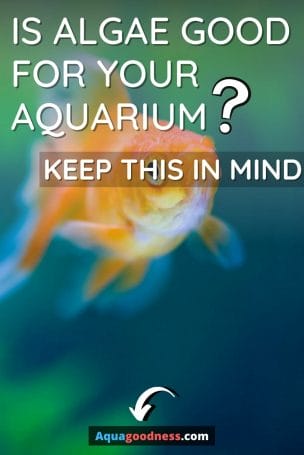
Table of Contents
What Does Algae Mean in a Tank?
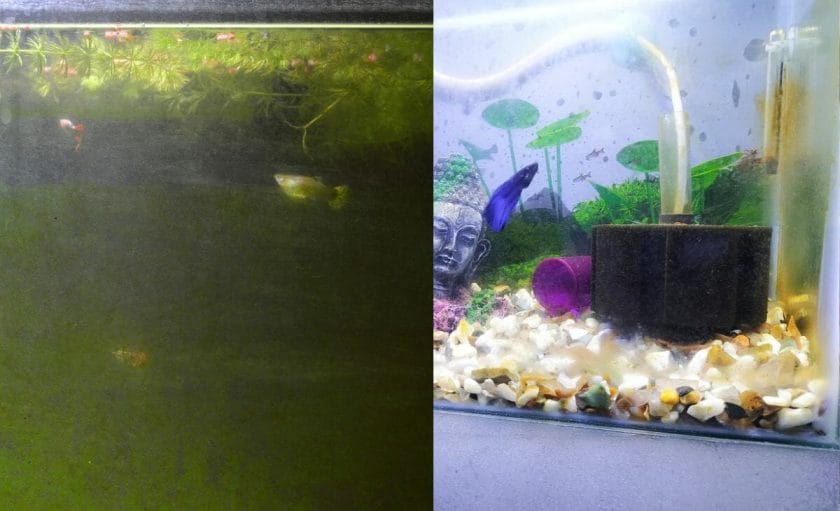
Algae is a general term for an extremely diverse group of organisms that live in colonies. Different species can cause different types of algae to appear.
You may see green, red, or brown fuzz, hair, or film on your tank when algae is present. These are each indicative of different tank conditions.
Quite often, however, the root cause of algae in a tank is overfeeding. An excess of nutrients in your tank allows plenty of food for the microorganisms that we associate with algae. Where food is abundant, life multiplies. Large quantities of organic matter cause population spikes in algae.
Another common cause is poor water quality, whether it be high levels of nitrogen, nitrates, or phosphates. These circumstances, unsurprisingly, can also be caused by overfeeding, although other tank conditions are also prone to causing an algal bloom.
Here are some types of algae and their common causes.
Brown Diatom Algae
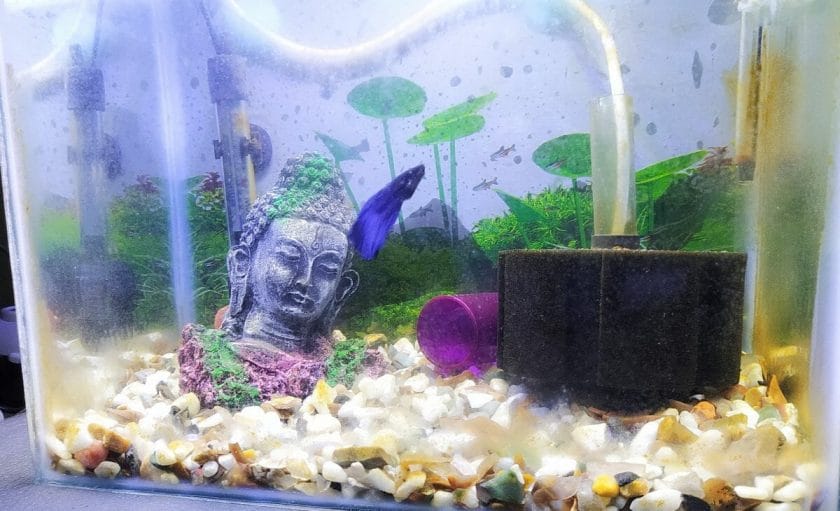
Although not actually algae, brown diatoms can multiply quickly in your tank, causing a brown slimy mess. You’ll see it start to form in brown, clumpy patches attached to your plants or substrate.
Brown diatoms can be caused by silicates in the water, the favorite food of diatoms. In abundance, silicates can cause an explosion in the diatom population. Tap water, salt mixes, live rocks, and live sand can all contribute to a high concentration of silicates in the water.
Nitrates and phosphates can also contribute to brown diatom population growth, conditions brought about by an excess of fish waste, poor tap water quality, plant fertilizers, and decaying organic matter.
Black Beard Algae
Black beard algae start out in tiny, reddish tufts but can quickly grow out of proportion if not put in check. It can grow almost anywhere, and a widespread algae bloom will result in dark-colored hairs on your plants, substrate, or decorations, much like a beard.
Black algae, like many other algae and diseases, can be introduced by decorations, plants, substrate, water, or materials from other tanks. The following tank conditions can also contribute to the growth of black beard algae:
- Inconsistent CO2 levels
- Rotting plants
- Overexposure to light
- Leftover fish food
- High levels of nitrate and phosphate
- Poor water filtration and circulation
Hair Algae
Hair algae look like a tangled green mass of hair that films over your plants. It’s most likely to spring up after you’ve recently cycled the tank.
Just because the nitrogen cycle has started to stabilize doesn’t mean conditions in your tank have settled–the process of balancing the ecosystem to be truly stable can take several months. Too much light, nutrient deficiency, and CO2 deficiency can also cause the growth of hair algae.
Green Water Algae
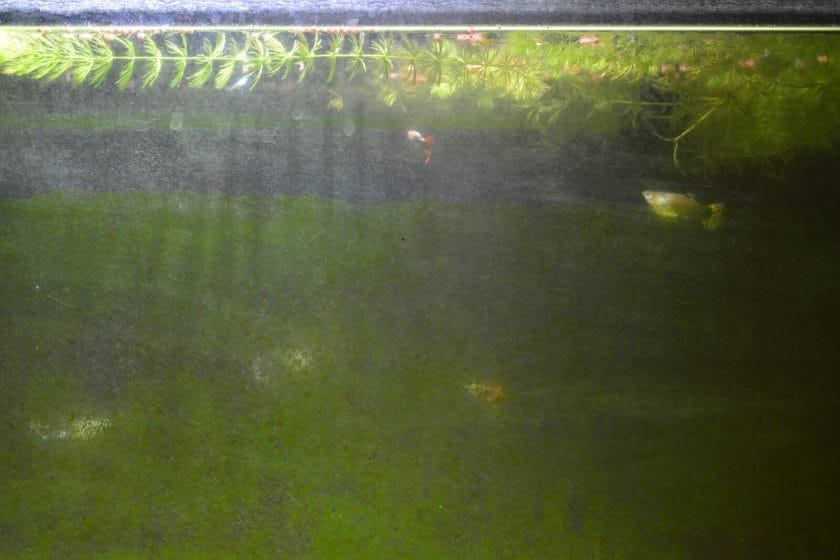
Free-floating green water algae is perhaps the most visually disruptive type of algae out there since it can cloud your entire tank and leave it a green, filmy mess.
Similar to other types of algae, green water algae thrive anywhere there’s light, CO2, and an excess of nutrients. As such, overfeeding is a common cause for a sudden explosion in green water algae population.
Is Green Algae Healthy in a Tank?
Green algae is a common type of algae that can occur in a tank. Not to be confused with green water algae, your bog-standard green algae isn’t harmful in low concentrations in a tank.
In fact, it generally indicates that your tank is experiencing a healthy balance. Nearly every tank will experience some degree of green algae, and some tank inhabitants even rely on the organisms that make up algae for food.
As long as conditions in your tank are stable, then you shouldn’t be overrun with a green algae bloom, although it can still occur even if you’re doing all the right things.
What to Do If Your Tank Is Overrun with Algae
Often, algae can arise as a result of a newly cycled tank. As the bacteria establish themselves, you may see a temporary uptick in the algae population.
If this happens, then don’t panic! Just keep testing your water to make sure your parameters are within normal ranges and monitor conditions for the next few weeks. If it’s cycle-produced algae bloom, then it should dissipate by itself.
Similarly, algal blooms caused by introducing new fish, substrate, plants, or live decorations to the tank can level themselves out over time, although you should always monitor tank conditions to see if the algae continue to worsen.
If it does, then it might be worth considering the underlying cause. A lack of water flow from a too-weak filter, overexposure to light, nutrient deficiency, and overfeeding can invite ideal growth conditions for algae and need to be addressed in order to reduce the algae population.
Methods to Remove Algae from Your Tank
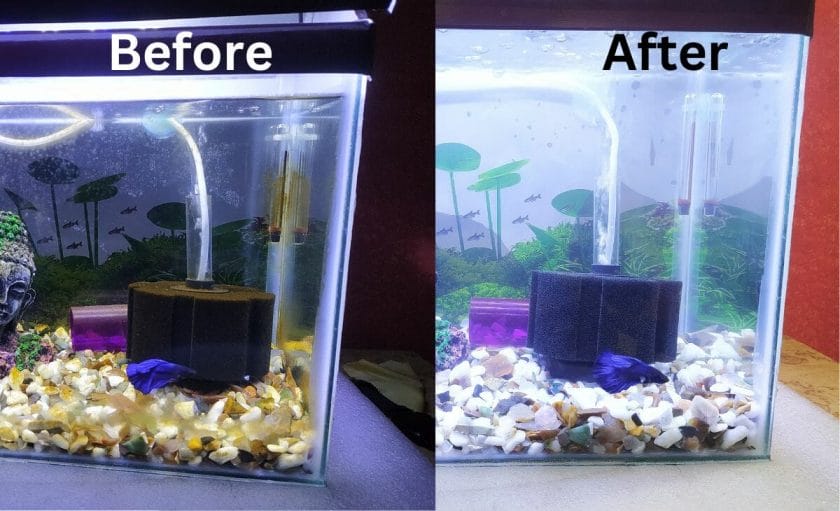
There are several methods you can use to get rid of algae in your tank, most of which are aimed at changing the conditions that allow algae populations to spread.
Take It Out By Hand
Hair algae can be removed by plucking it directly from the decorations or substrate and discarding it. Of course, you might want to consider the above underlying conditions (i.e., light exposure, overfeeding, etc…) and address those.
Install a UV Sterilizer
A UV sterilizer does exactly what the name suggests: completely inhibits the algae spores’ ability to reproduce. Not only can this effectively combat the spread of algae spores, but it’s also a useful tool for combating parasites and other diseases.
Keep in mind that a UV sterilizer is only effective against algae that comes into contact with UV light; in other words, free-floating bacteria, parasites, and algae circulated through the tank will be rendered inert, but attached algae may not.
Still, a UV sterilizer is an excellent tool to keep your water looking crystal clear and combat algal blooms.
Manage Nitrate Levels
Nitrate is the primary food for algae, and this chemical compound goes unchecked in your tank until you do a water change.
Remember that the nitrogen cycle goes from ammonia to nitrite, then nitrates. The nitrates, the least harmful of these compounds to fish, continue to build up in your tank until you dilute it through a water change. If the levels are too high because of infrequent water changes, then algae could set in.
The simple solution–not to fix the algae problem, but to slow the spread and prevent future blooms–is to water change more often. A general rule of thumb is to water change whenever your nitrates approach 40 ppm.
Remove Uneaten Food
Uneaten food contributes to an excess of nutrients, food for algae that prompt them to reproduce in greater numbers.
As such, carefully monitor what you feed your fish and remove any leftover food an hour or two after feeding time. This simple change can not only help avoid destabilizing the chemical profile of your tank, but it can also reduce the risk of algae blooms.
Do Aquarium Plants Reduce Algae?
Add an Aerator
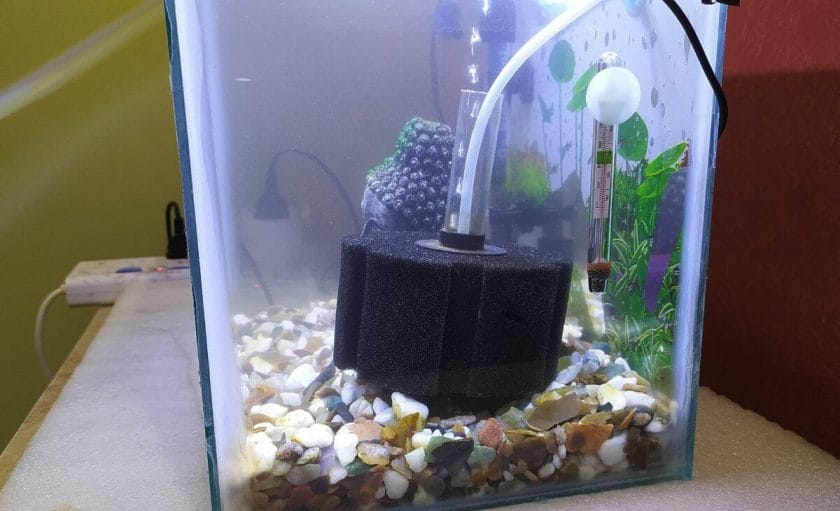
Low oxygen levels and a lack of surface movement can create conditions for algae to thrive. An aerator is a great addition to most tanks since it oxygenates your water and provides some level of surface movement.
In addition, an aerator is great for live plants, since they rely on oxygen to thrive. I love the Tetra Whisper Air Pump, since it’s quiet and works great for smaller tanks.
Move Your Tank
As mentioned, too much light can dramatically increase the rate at which algae reproduce. If your tank is constantly exposed to sunlight, you may find that you have issues with algae.
Putting your tank somewhere that doesn’t get sunlight can help you avoid pesky green algae blooms.
Get an Algae Eater
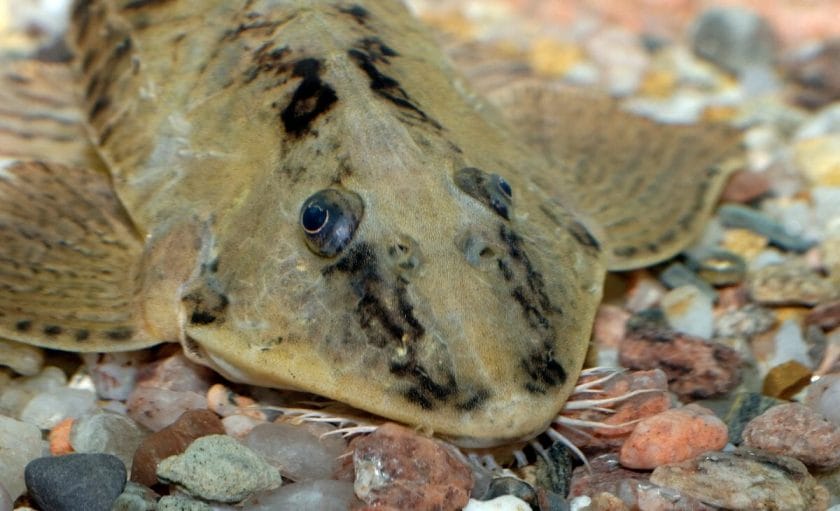
Algae eaters will not fix your underlying problem or deal with algal blooms on their own, but they can help keep pesky green films off your glass. Plus, they make for some great tankmates.
Personally, I recommend getting Nerite Snails, Cherry Shrimp, or Bristlenose Plecos. Of course, you want to consider the bioload that these new additions add to your tank–you wouldn’t want to overstock your tank just to fix an algae problem!
In addition, make sure the algae eaters you choose are compatible with other fish. Cherry Shrimp, for example, are not compatible with Angelfish, Loaches, Gouramis, and Catfish.
6 Best Aquarium Plants to Prevent Algae (Detailed information)
FAQs
Is Algae Helpful or Harmful?
Some green algae generally indicate that your fish tank is a-ok, but as with anything, too much algae is harmful. It can out-compete your plants for nutrients, starve your tank of light, and mess with your tank parameters in unwanted ways. Oh, and it looks pretty awful, too.
Some species of algae are more harmful than others and warrant immediate attention, but standard green algae isn’t something to be worried about in low concentrations.
What Are the Best Algae Eaters?
Snails are the best algae eaters since they spend most of their time feeding on it. They’ll also eat any detritus such as rotting plant matter, and keep your tank tidy.
Of course, never exclusively rely on these gastropods as your “cleanup crew”; they actually produce quite a lot of waste. Even so, they’re quite reliable at keeping your glass clean and clear.
Conclusion
Algae is helpful in a tank environment as a whole since it serves to oxygenate the water and is usually indicative of a healthy aquarium ecosystem. Too much, however, can be a problem, in which case you’ll want to invest in a UV sterilizer or consider how you’re maintaining your tank.
Be sure to read this article to see what you might be doing to unintentionally encourage an algae bloom so that you can fix it quickly!
